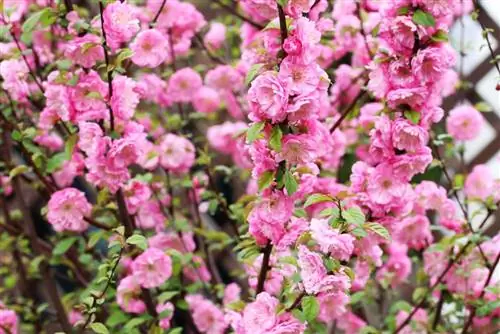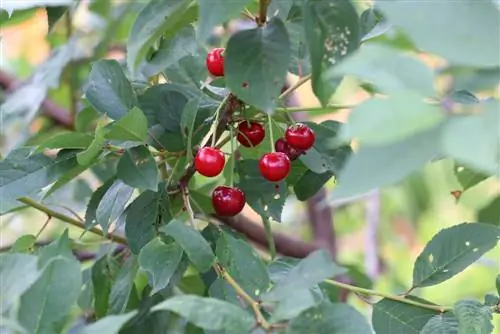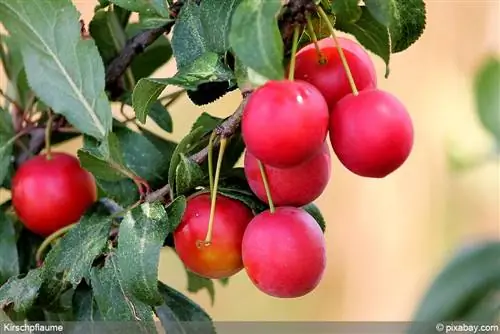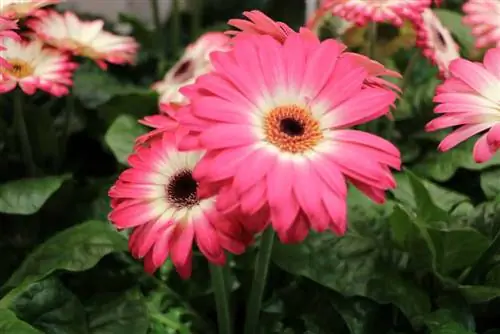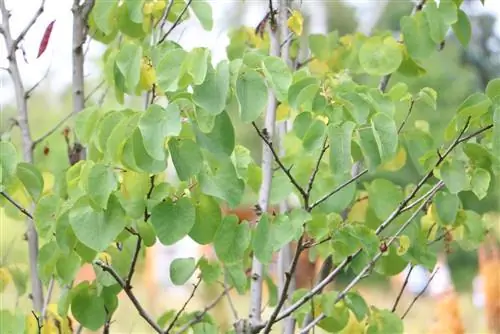- Author admin [email protected].
- Public 2023-12-17 03:39.
- Last modified 2025-01-24 12:45.
An almond tree doesn't skimp on flowers. He liberally decorates his branches with them from March onwards. Not even a tiny spot is left for the green leaves. They have to be patient until the flowers fall to the ground withered. It deserves a clearly visible place in the garden so that it can spread spring joy with its pink mood. With the right care, it blooms extremely reliably.
Species
Prunus dulcis can develop into a tree up to seven meters high or grow in bush form. Different subspecies are known: bitter almond, sweet almond and cracked almond. If you want to harvest your almond in autumn, you can use the Palatinate fruit almond 'Palatina' or the 'Princess Amanda'. But in our country the almond grows mainly as an ornamental tree and less because of its tasty fruits. The ornamental almond, Prunus triloba, is an ideal species for those who particularly value the flowers. Hardly any or no fruit ripens on it, but it is also hardy here, and its flowers are also less sensitive to frost.
Location
An almond tree needs a location in the garden where it is well protected from icy winds. Although the tree is hardy, its early flowers are its weak point. The first flowers appear in March, long before the green leaves appear. They don't like temperatures that are too low, especially frost. But that's exactly what they have to expect at this early time in this country.
- Vine-growing locations with a mild climate are also well suited for the almond tree
- he likes partial shade, where he is protected from too bright sun
- needs a lot of light
- fresh flowers and leaves are sensitive to morning sun
- young trees in particular are sensitive to heat
- They don't get drafts either
- Location on a southwest wall is ideal
Floor
The almond tree also thrives in normal garden soil. It should be deeply loosened so that it is permeable to air and water. Compacted soils tend to become waterlogged and are less suitable for an almond tree. It can't tolerate roots that are too wet; it can cope better with dry conditions. A calcareous soil with a pH value above seven is optimal for it.
Pouring
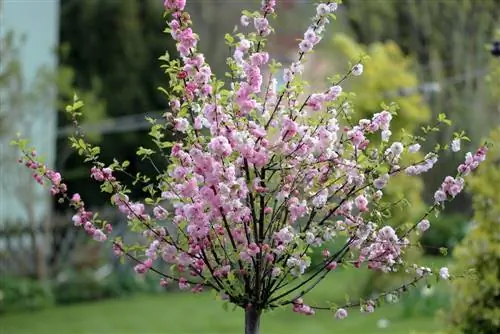
Almond trees tolerate drought well. If there is little rainfall during the vegetation phase, it does not harm the trees. On the contrary, this suits their needs. It is therefore not necessary to reach for the water hose at all. Only recently planted trees have not yet formed a sufficiently strong root system and still require support. During a long period of drought, young trees need to be watered regularly. As soon as the soil is dry, water it abundantly.
Fertilize
Older almond trees are easy to care for and do not require any fertilizer. Once a year the soil should be loosened by digging up the top layer. Young trees that still need to grow need plenty of nutrients. The nutrients in the soil alone are not enough; additional nutrients must be specifically added to it. Fertilization should take place in spring. Mature compost or special fertilizer for fruit trees can be used for this.
Plants
If you want your almond tree to thrive and delight you with plenty of flowers every spring, you should give it a good start. The timing of planting is just as important as a careful approach. This is the only way to find optimal growth conditions right from the start. There is no longer any great heat to be expected in late summer, so this time is a wonderful time to move an almond plant outdoors. Alternatively, early spring is a suitable planting time.
- Place the pot with the almond in a bucket filled with water. It can remain there for about 15 minutes until the root ball is soaked with water.
- Choose a suitable, protected location.
- Dig a planting hole that is at least twice the size of the current pot.
- Loosen the soil deeply.
- Remove stones and old roots.
- Lay down a drainage layer if the soil is heavy.
- Mix heavy soil with sand, lean soil with compost or humus.
- Slightly shorten all shoots of the almond tree so that it does not lose too much water through evaporation and the risk of drying out is averted.
- Carefully remove the plant from the pot and place it in the prepared planting hole. The planting depth corresponds to the growth in the pot.
- Fill the hole with soil and water the almond lightly.
- Water the planted almond tree regularly with water until it has grown well.
Note:
If your almond tree is a souvenir from vacation, it could be that it is not sufficiently hardy in this country. Container keeping is the safer option for its cultivation.
Bucket keeping
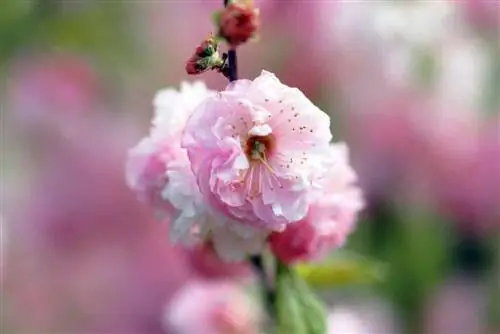
If you don't have a garden or are not sure whether your almond bush is hardy, you can keep the plant in a sufficiently large container. Like all potted plants, the almond needs to be watered and fertilized more frequently. A drainage layer is important so that waterlogging does not form in the bucket. The potted plant needs care measures such as pruning and a suitable location protected from wind and sun, just like the almond growing outdoors. The pot size should always be adjusted to the growth of the shrub.
Conservation cut
Regardless of whether it is an almond tree or an almond bush, both need occasional pruning so that they continue to grow strong and he althy. During maintenance pruning, all parts of the plant that somehow hinder growth and flowering are removed.
- it is possible almost all year round if the temperature is above 5 degrees Celsius
- Nevertheless, the time after flowering is ideal
- pruning dead branches
- all shoots whose growth direction does not suit the plant must be removed
- Remove wild shoots on the trunk or roots completely
- Cut off shoots that cross each other close to the trunk
- remove thin shoots completely
- Maintenance pruning is recommended every two to three years
Tip:
The almond tree tolerates pruning well. Feel free to cut off all disturbing shoots generously. The almond tree will produce enough new shoots.
Rejuvenation cut
The almond tree blooms on young, annual wood. In order for the flowers to be plentiful every year, old parts of the plant must be removed regularly. In addition, a crown that is too dense prevents the rapid evaporation of moisture and thus makes the plant susceptible to fungal diseases.
- Time immediately after flowering
- May, June at the latest
- Cutting trees and bushes
- Crops are cut after harvest
- Cutting day may be slightly cloudy, but free of rain
- Short shoots of young plants to half
- on old plants only a few eyes should remain per shoot
Note:
The flowers for the coming year are already formed in autumn. Pruning in winter would significantly reduce flower formation.
Rejuvenation pruning promotes flower formation and crown branching. At least three to five leading branches should remain on the almond tree. In addition, it tolerates all cuts.
Propagation by sowing

Refined small almond trees are usually available in stores that can be planted in the garden bed or kept in a pot. However, it is also possible to grow an almond tree from an almond kernel. The almond must be untreated and first removed from its hard shell. If you leave the kernel in the hard shell, it can take months until it finally germinates.
- Slightly score the shell with a saw or a nail file. Or carefully split the peel. The core must not be damaged.
- Prepare a pot with potting soil and moisten it well.
- Insert the core into the moist soil, about 1 to 2 cm deep.
- Cover the pot with foil to keep the soil moist.
- Place the pot in a bright place but protected from the sun; the temperature should be around 20 degrees Celsius.
- The first leaves appear after weeks. Then remove the foil. The pot can be kept warm and bright, but without direct midday sun.
- After about a year, the tender plant should be transplanted into a pot.
Note:
If the origin of the almond kernels is not absolutely clear, the properties of the resulting almond plant are also unknown. Above all, the question arises about winter hardiness.
Propagation by cuttings
In summer, semi-lignified shoots can be used as cuttings. They are first coated with a rooting hormone and then placed in moist potting soil. Experience has shown that the chances of these cuttings rooting are low. There should be no great expectations attached to it. If it still works, it's wonderful.
Wintering outdoors
Many types of almonds are also suitable for our latitudes. They survive even harsh winters without suffering any damage. However, they thrive better in milder areas; at least they should be given a place protected from the wind. The flowers of all almond varieties are sensitive to frost. If the flowers are hit by frost, they will appear sparser and the harvest will suffer. The tree itself remains alive. Nothing prevents it from blooming profusely again next year. After winter, the tender shoots must be protected from the midday sun. If the midday sun shines on its location, it should be kept away from the tree with reed mats or something similar.
Wintering in a bucket
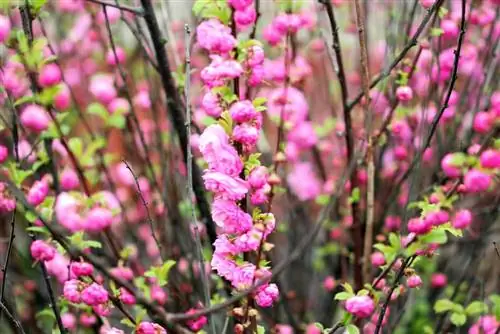
All types of almonds that are not hardy or whose winter hardiness is not known with certainty should overwinter in a bucket. The winter quarters should be between 5 and 10 degrees cold. The overwintering room cannot be warmer because the almond tree needs winter rest in order to produce more abundant flowers later. The apartment is far too warm for this plant and absolutely unsuitable for overwintering. The almond tree would sprout again immediately. Watering is rarely done in winter quarters, only when the soil dries out. In autumn the ornamental almond loses its leaves and therefore does not need any light in its winter quarters. Light is only absolutely necessary before new growth begins. The pot should then be sufficiently bright, otherwise the new shoots will become thin and unsightly.
Diseases
The almond is a resilient plant, provided it receives regular pruning to keep its crown airy. If the ornamental almond and all other types of almonds are not cut and thinned at all for years, a very dense crown develops. Moisture cannot evaporate quickly and forms the ideal environment for various fungal diseases.
Tip drought, also known as monilia, is particularly feared in almond trees. The reason for this fear is that there is no effective pesticide against this disease. If it spreads too much, it can become life-threatening for the tree. The fungus penetrates the flowers in damp weather and causes the shoot tips to dry out. The tree defends itself against this with a rejection reaction. A rubbery coating can be seen at the transition points to he althy wood. The only rescue measure is cutting.
- cut immediately
- Disinfect scissors and other cutting tools
- remove all diseased shoots
- Cut up to 15 cm into he althy wood
- Seal interfaces with tree wax to prevent fungal spores from entering
- Tighten the plant preventatively so that the crown is ventilated
- Burn the cuttings or dispose of them in the trash
- Check the plant regularly
- if applicable carry out further cutting measures
Tip:
Prevent fungal diseases by thinning the almond plant regularly.
The so-called curl disease is also a fungal infection that affects the almond and against which there is no effective pesticide. Just like with Monilia, all diseased parts of the plant should be cut off as quickly as possible. These can be easily recognized by the curled leaves that gradually fall off.
Pests
Aphids are pests that the almond plant can occasionally suffer from. However, they can be easily combated with various natural remedies. The earlier the infestation is discovered, the quicker and more effectively these pests can be combated.

